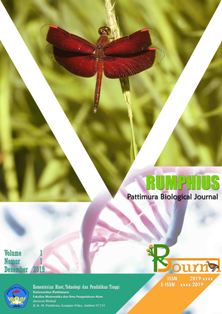POTENTIAL OF COLI FRUIT AS ANIMAL FEED IN MOA DISTRICT SOUTHWEST MALUKU
Abstract
This study aims to determine the distribution area and population of Koli trees on Moa Island and to determine the amount of fruit and mesocarp juice in one production. This research used a survey method, simple random interviews of 30 respondents and direct observation at the research location. Research variables: Respondent profile: age, gender, education level and occupation. Coli tree population structure. Calculating the production of cauliflower and mesocarp fluid. The results of the study: Respondents' age was 23-64 years old, male sex (100%), education level of respondents: Elementary school graduates (SD) 70%, respondent's main occupation: farmer 93.33%, sideline: breeder 80.00%. Koli tree production area/sample village: 16,000m2/1.6Ha consisting of 4 lanes, area of each lane 4,000m2/0.4Ha, consisting of 4 plots, area of each plot: 1,000 m2/0.1Ha, number of coli trees per plot : 8 trees, number of koli trees in the production land area/village: 8×4×4=128 trees. Coli fruit production for 1 harvest is 20 bunches × 20 fruit = 400 fruit/tree, multiplied by the number of koli trees from one village: 400×128 = 51,200 fruit harvested 2/year: 51,200×2 = 102,400 fruit/village/year, liquid mesocarp/fruit: 260grams and 446grams. Mesocarp fluid/village: 446 gram×102,400 fruit = 45,670,400 gram/45,670.4 Kg/45.7 Ton (large fruit), 260 gram×102,400 fruit = 26,624,000 gram/26,624 Kg/26.62 Ton (small fruit). 1 year mesocarp fluid production in 3 sample villages is 79.86-137 tons/year.
Downloads
References
Ardiansyah, T. 2016. Forest Inventory: Sampling Technique with Sample Units of Different Sizes.
Dewati, R. 2010. Reaction kinetics of making oxalic acid from siwalan fiber with the oxidizer H2O2. Journal of Engineering Science Research, 10(1), 29-37.
Fajeriadi, H., Dharmono, D., & Anwar, M. R. 2019. Density of palm palm (Borassus flabellifer L.) in the coastal forest of Tabanio Village, South Kalimantan. EnviroScienteae, 15(2), 190-194.
Hardiyanti, H. 2019. Testing of Density, Water Content and Absorption Coefficient of Acoustic Boards using Palm Leaf (Borassus Flabellifer) Basic Material (Doctoral dissertation, Alauddin State Islamic University Makassar)
Idayati, E., Suparmo, S., & Darmadji, P. 2014. Potential of Bioactive Compounds in Mesocarp of Lontar Fruit (Borassus fl abeliffer L.) as a Source of Natural Antioxidants. Agritech, 34(3), 277-284.
Jihad, M. 2012. Identification of the Morphology of the Arecaceae Family in Gowa Regency (Doctoral dissertation, Alauddin State Islamic University Makassar).
LINA, N. 2018. Feasibility Analysis of Palm Brown Sugar (Borassus Flabellifer) Processing Business.
Marlistiyati, M., Mahayasa, M., & Pelokila, M. R. 2016. Utilization and Economy of Lontar for the Community in Kupang City. Sustainable Earth Journal, 16(2).
Nainggolan, R. R. 2017. The Influence of Farmers' Socio-Economic Factors on Dairy Cattle Management Patterns in Lembang District, West Bandung Regency. Wahana Bhakti Praja Scientific Journal, 7(2), 127-138.
Penuara, L. 2012. Reproductive Performance of Parent Goats on Moa Island, Moa Lakor District, Southwest Maluku Regency.[Thesis]. Ambon: Department of Animal Husbandry, Faculty of Agriculture, Pattimura University.
Rosyida, F. 2014. The effect of the amount of sugar and citric acid on the organoleptic properties, water content and microbial number of dried candied siwalan (Borassus flabellifer). Journal of Culinary Management, 3(1).
Tambunan, P. 2010. Potential and policies for palm oil development to increase population income. Journal of forestry policy analysis, 7(1), 27-45.
Tnunay, I. M. Y., Hanas, D. F., & Mata, M. H. 2023. Characteristics of Palmyra Fruit and Seeds (Borassus Flabelifer L.). BIOEDUSAINS: Journal of Biology and Science Education, 6(1), 172-177.
Authors who propose a manuscript and have it approved for publication know that the manuscript will be registered and become part of the RPBJ. Authors and readers understand that this journal is open and all its contents can be accessed freely, provided that RPBJ is still listed as the source of information. The hope is that this journal can become a vehicle for exchange and scientific knowledge for society and the scientific community, especially in the field of Biology and other branches of science.









